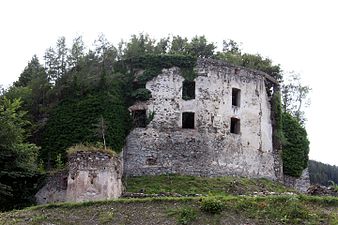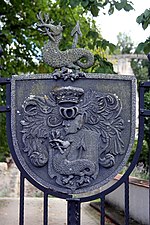Stickelberg castle ruins
| Stickelberg castle ruins | ||
|---|---|---|
|
Stickelberg castle ruins seen from the north |
||
| Creation time : | before 1259 | |
| Castle type : | Hilltop castle | |
| Conservation status: | ruin | |
| Place: | Stickelberg | |
| Geographical location | 47 ° 36 '45.1 " N , 16 ° 14' 25" E | |
|
|
||
The castle ruin Stickelberg (historical name castrum Steckilberc ) is the ruin of a hilltop castle on a ridge in the village of Stickelberg in the municipality of Hollenthon in the Wiener Neustadt-Land district in Lower Austria . It is privately owned and is now in ruins. Due to the dilapidation, the castle ruins, which are under monument protection ( list entry ), cannot be visited.
history
Who was the builder of the castle lies in the dark of history. The castle was first mentioned in a document in 1259 in the will of Berthold von Treun . In this he bequeathed the castle to the Austrian sovereign and Bohemian king Ottokar II Přemysl , making the castle sovereign. Berthold von Treun came from the area around Pettau in today's Slovenia . He had to leave for Austria after taking part in an unsuccessful uprising of the Lower Styrian landed gentry against the Hungarian governorship . In a document from 1305, Heinrich and Ludwig von Stickelberg are named as witnesses.
The castle ruins stand on a circular fall dome and are separated from the hinterland by a ditch . The old circular wall , which is 12 meters high and 120 to 180 centimeters thick, stretches around the mound . It had two entrances, which were secured with pulley drawbridges . The expansion of the inner wall suggests that this was the main line of defense. In order to create an additional obstacle, the Stickelberger Bach passing at the rear could be dammed.
Leutold von Stickelberg , who served as the Duke's chamberlain in 1397, was the most important member of the Stickelberg family. Since this activity gave him little time to take care of the family property, he appointed a burgrave as administrator. Thanks to his services as Burgrave of Mödling, he was granted blood jurisdiction for Stickelberg . As Stickelberg Castle primarily had administrative tasks, it was not included in the conflict between Emperor Friedrich III and Matthias Corvinus .
Over the years the castle has been extensively rebuilt twice. So around 1400 the defenses were significantly strengthened. Reinforcing pillars were attached to the curtain wall in the north-east and south-west, which are 250 centimeters thick.
Around 1600 a new residential wing was built on the entire north side. In the corner a staircase tower between the old was Palas and the new wing built. The gate to the inner courtyard was covered by a kennel . The entrance ran along the entire east side. It was protected from the outside on the one hand by the outer curtain wall and on the other hand by an elongated bastion that rose four meters from the ground. The outer perimeter wall was protected with five more protruding acute-angled bulwarks. Since the interior was relatively small, only two men could have been provided for it. The moat on the north side was more than 20 meters wide and the floor was 9 meters below the threshold. The prefix rampart was arranged in a semicircle and had a crown width between nine and ten meters. It dropped more than three meters on the inside and more than six meters on the outside. The western end was widened like a bastion .

The brothers Andreas and Ulrich von Weißpriach bought the castle from Georg von Stickelberg in 1497 . In 1558 they illegally sell the castle - it was a sovereign fiefdom - to Ulrich von Neidegg . Since they had received a large loan from Johann von Weißpriach , Emperors Ferdinand I and Maximilian II legalized the feudal relationship. In 1607 the castle was sold to Ehrenreich Wurmbrand . This brought Stickelberg into a Fideikommiss at that time .
Because of its small size, the castle was of no strategic importance. Nevertheless, it was still integrated into the country's chalk fire system in the first half of the 16th century . Due to its small size, the castle was not very suitable as a refuge from the Turkish invasions.
In 1705 the Wurmbrands divided the estate. Stickelberg came to Johann Wilhelm Wurmbrand . In 1749 he managed to bring the entire family property together into his hands. The Stickelberg castle ruins, which are connected to the Steyersberg rulership , have remained with the Wurmbrand-Stuppach family to this day .
In the 17th century, the facility was at least temporarily inhabited. It is not known when the castle began to fall into disrepair. The engraving by Georg Matthäus Vischer in the Topographia Austriae superioris modernae shows it as a still undamaged small tower castle (see picture on the left). Presumably as a result of the union with Steyersberg , the castle deteriorated more and more over time. The introduction of the door and roof tax around 1810 also accelerated the decline.
The so-called “Jägerhaus”, which is in front of the castle, was renovated in the 20th century and adapted again for residential purposes.
gallery
literature
- Sepp Birnbauer: The Stickelberg Castle in the home book of the Hollenthon community, 700 years of Hollenthon, pages 39 ff; Published by Hollenthon Municipality, 1995 (without ISBN)
- DEHIO Lower Austria south of the Danube ; Verlag Berger, Horn 2003, ISBN 978-3-85028-364-9
- Felix Halmer: Castles and palaces Bucklige Welt, Semmering, Rax ; 1969
- Georg Binder: The Lower Austrian Castles and Palaces, Volume 1 ; A. Hartleben's publishing house, Vienna 1925, ISBN 978-0656785711
- Georg Clam Martinic: Austrian Castle Lexicon ; Verlag A & M, 1992, ISBN 978-3902397508
- Ilse Schöndorfer: Stones and Legends - Castle ruins in Lower Austria ; Verlag Niederösterreichische Pressehaus, St. Pölten 1999
- Gerhard Stenzel: From castle to castle in Austria ; Verlag Kremayr and Scheriau, 1973, ISBN 978-3218002783
- Weltin / Mochty / Kühtreiber / Woldron: Defense buildings and aristocratic residences in Lower Austria / The quarter under the Vienna Woods, Volume 2 ; Verlag Niederösterreichisches Institut für Landeskunde, 2003, ISBN 978-3901635021
Web links
- Burgen Austria: Stickelberg (accessed on August 26, 2016)
- Defense structures in Austria: Stickelberg castle ruins (accessed on August 26, 2016)
- Austria Forum: Stickelberg Castle Ruins (accessed on August 26, 2016)







